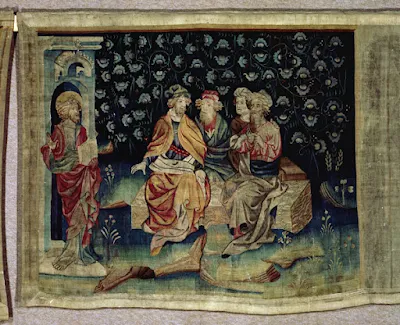This is the last of three posts about one of the most remarkable artistic representations of the book of the Apocalypse, a series of six enormous tapestries created in Paris between 1377 and 1382. (See part one and part two.) They were commissioned by Louis I (1339-84), the second son of King Jean II of France, and first Duke of Anjou; his grandson and third successor to his title, René, donated them to the cathedral of Angers, the capital of the duchy, in 1480. Each of them begins on the left with a man sitting under a Gothic baldachin, reading the Apocalypse from a book on a stand in front of him. There follow 14 scenes of St John’s visions arranged in the order of the book, running from left to right, first above and then below, making for 15 panels per tapestry, an original total of 90 scenes between the six.
After being plundered and cut into pieces during the Revolution, the surviving parts were recovered in 1848. The fifth and sixth tapestries, the most badly damaged, are shown in this post; the former lost three full scenes and parts of two others, while the latter lost five, as well as its reader, and its last two scenes survive in fragments. The images here are taken from this page of Wikimedia Commons, which shows the arrangement of the panels divided by tapestry (by PMR Maeyaert, CC BY-SA 4.0.)The sixth tapestry is lacking its reader and the first two scenes of the upper register, which showed the rider on the white horse, who “treadeth the winepress of the fierceness of the wrath of God the Almighty” (19, 15), and the birds which come to eat the flesh of the mighty whom he casts down (19, 17-18). Here, He fights with “the beast, and the kings of the earth, and their armies gathered together to make war with Him” (19, 19).




















.jpg)